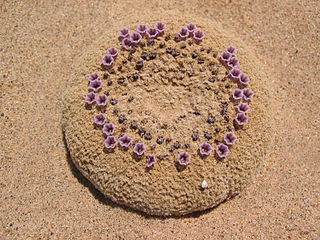
Pholisma sonorae, commonly known as sandfood, is a rare and unusual species of flowering plant endemic to the Sonoran Deserts to the west of Yuma, Arizona in the California Yuha, Mojave Desert and Colorado Desert, and south in the Yuma Desert, where it is known from only a few locations.

Tiquilia is a genus of flowering plants in the borage family, Boraginaceae. The 27 species in this genus are known by the common name crinklemat. They are native to the Western Hemisphere and are mostly found in desert regions.
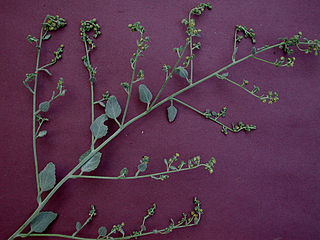
Dicoria canescens is a North American flowering plant in the family Asteraceae known by several common names including desert twinbugs and bugseed. This is a desert plant of the southwestern United States and northwestern Mexico, found in Sonora, Baja California, southern California, Nevada, Arizona, Utah, southwestern Colorado, and northwestern New Mexico.

Peucephyllum is a monotypic genus of flowering plants containing the single species Peucephyllum schottii. Its common names include pygmy cedar, Schott's pygmy cedar, desert fir, and desert pine. It is not a cedar, fir, or pine, but a member of the aster family, Asteraceae. It is a leafy evergreen shrub with glandular, resinous foliage. It flowers in yellow flower heads which have only disc florets. The fruits are woody, bristly seeds with a pappus. This plant is native to the deserts of Arizona, California, Nevada, and Utah in the United States and Baja California and Sonora in northern Mexico.

Tetracoccus dioicus, known by the common names red shrubby-spurge and Parry's tetracoccus, is a species of flowering plant.

Trixis californica , the American threefold or American trixis, is a species of flowering plant in the family Asteraceae. It is native to the southwestern United States in California, Arizona, New Mexico, and Texas, and in Mexico in the states of Baja California, Chihuahua, Coahuila, Durango, Nuevo León, Sinaloa, Sonora, Tamaulipas, and Zacatecas.

Condea emoryi, the desert lavender, is a large, multi-stemmed shrub species of flowering plant in Lamiaceae, the mint family.

Senecio flaccidus, formerly recorded as Senecio douglasii, member of the daisy family and genus Senecio also known as threadleaf ragwort, is a native of the southwestern Great Plains of North America.
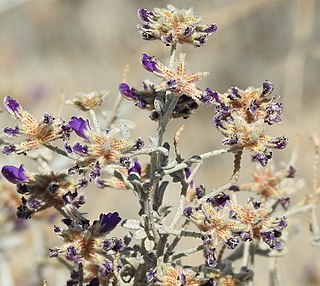
Psorothamnus emoryi, common names dyebush, white dalea, or Emory's indigo bush, is a perennial legume shrub or subshrub common to the desert mesas of the southern part of the U.S. states of Arizona and California, and regions of the Mexican state of Baja California.

Tiquilia plicata, the fanleaf crinklemat or fan-leaved tiquilia, is a perennial, subshrub-like plant of lower elevation deserts in the family Boraginaceae, the borages and forget-me-nots. It is found in the southwestern United States and northwestern Mexico, in the states of California, Nevada, Arizona, Sonora, and Baja California. It is a short, low-growing plant, seldom over 12 in tall.

Galium multiflorum is a species of flowering plant in the coffee family known by the common names Kellogg's bedstraw, shrubby bedstraw, and many-flowered bedstraw. It is a perennial herb that grows on rocky soils, mountains, and desert slopes.

Hibiscus denudatus is a perennial shrub of the mallow family, Malvaceae. It is in the rosemallow genus, Hibiscus.

Tiquilia nuttallii is an annual, subshrub-like plant of middle and higher elevation deserts in the family Boraginaceae - borages or the forget-me-nots. It is found in western North America from central Washington to western Colorado, and northern California and northern Arizona; it is also found in a disjunct population in Missouri.

Ceanothus pauciflorus, known by the common name Mojave ceanothus, is a species of flowering shrub in the buckthorn family, Rhamnaceae. It is native to the Southwestern United States and Mexico, where it grows primarily in shrubland communities at moderate to high elevations. It is characterized by oppositely arranged leaves, corky stipules and white flowers. It was formerly known as Ceanothus greggii.

Tetracoccus hallii is a species of flowering shrub in the family Picrodendraceae, known by the common names Hall's shrubby-spurge and Hall's tetracoccus.
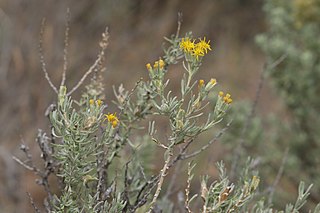
Tetradymia argyraea is a species of flowering plant in the aster family known by the common names spineless horsebrush and gray horsebrush. It is native to western North America.
Tiquilia palmeri is a species of flowering plant in the borage family known by the common names Palmer's crinklemat and Palmer's tiquilia.

Ziziphus obtusifolia is a species of flowering plant in the buckthorn family known by several common names, including lotebush, graythorn, gumdrop tree, and Texas buckthorn.
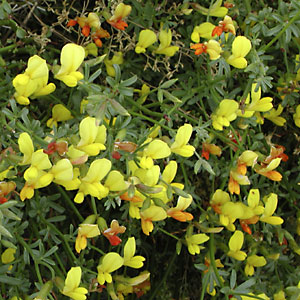
Acmispon rigidus, synonyms Lotus rigidus and Ottleya rigida, is a flowering plant in the pea family (Fabaceae), native to the southwestern United States and northwestern Mexico. It is known as shrubby deervetch or desert rock-pea. It is found in the Mojave Desert and Sonoran Desert.

Ambrosia monogyra is a species of flowering plant in the sunflower family commonly known as the singlewhorl burrobrush, leafy burrobush, slender burrobush, and desert fragrance. Ambrosia monogyra is native to North America and is typically found in canyons, desert washes, and ravines throughout arid parts of the southwestern United States and northern Mexico. This species has green, threadlike leaves that emit a distinctive odor when crushed, and flowers from August to November. The fruits have distinctive wings in their middle that aid in dispersion through wind and water.




















